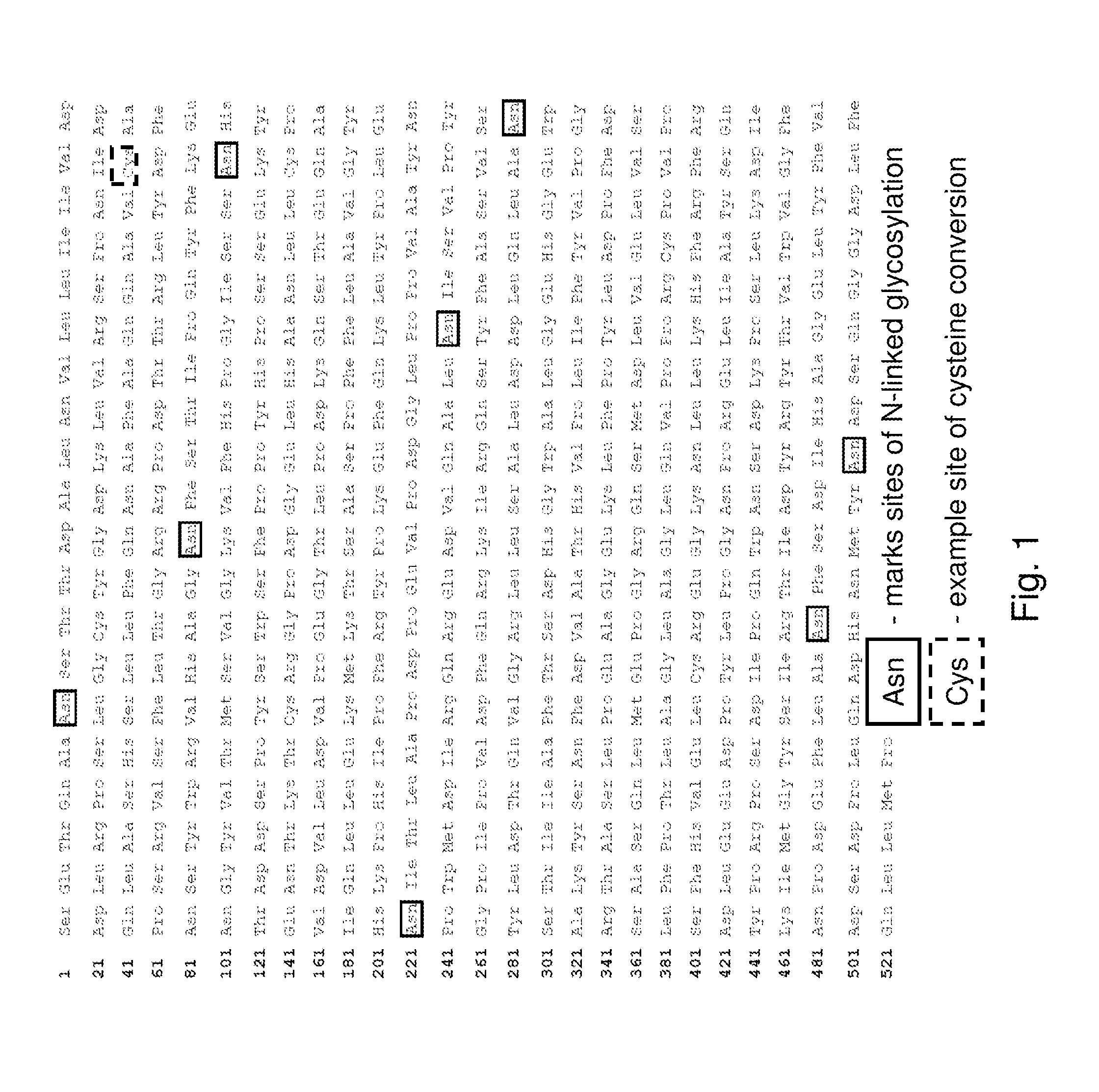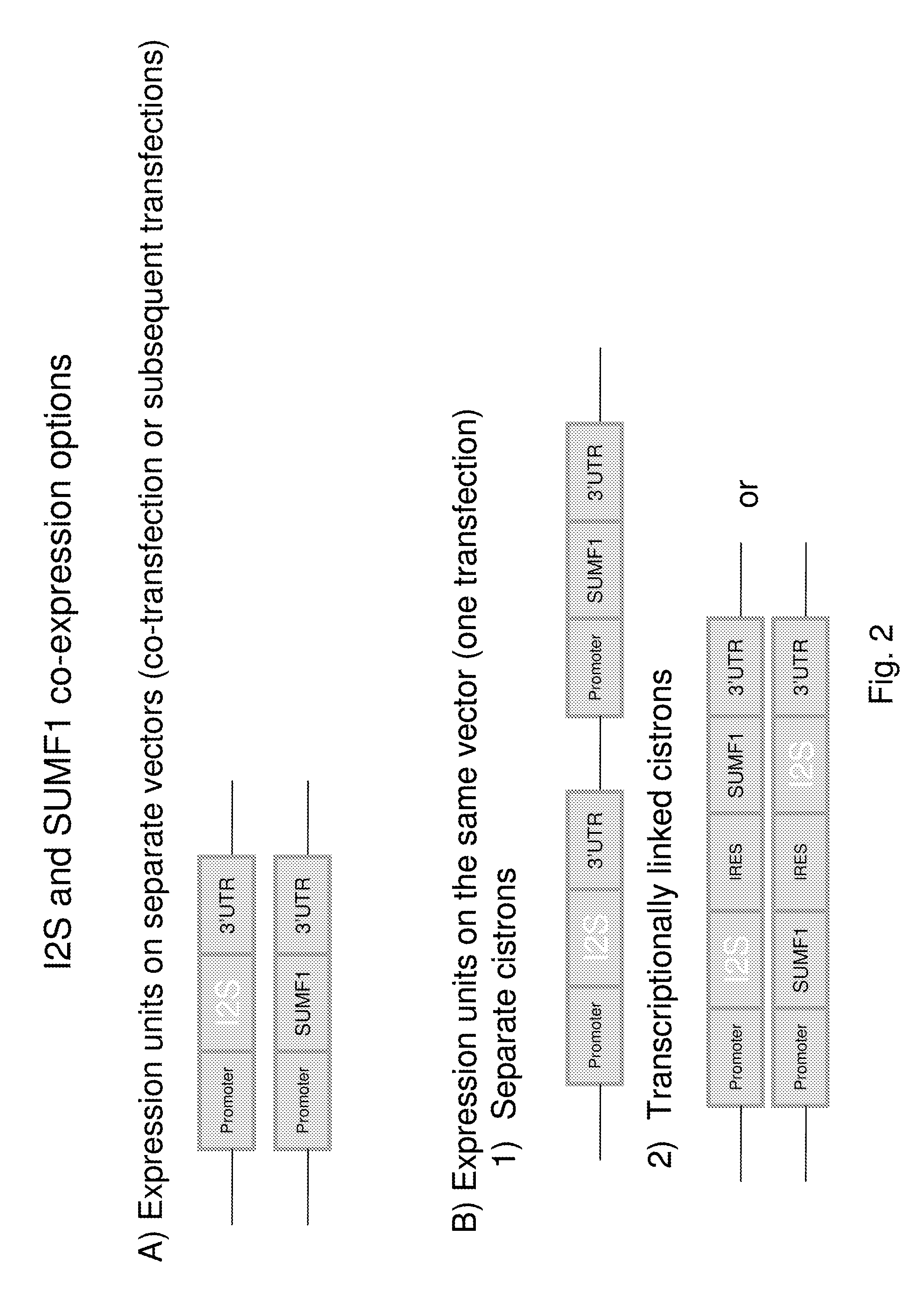Method of producing recombinant iduronate-2-sulfatase
a technology of iduronate and sulfatase, which is applied in the field of producing recombinant iduronate2sulfatase, can solve the problems of affecting the effect of i2s enzyme production, and reducing the production efficiency of i2s enzyme, so as to facilitate the effective treatment of hunter syndrome and large-scale production. , the effect of reducing the accumulation o
- Summary
- Abstract
- Description
- Claims
- Application Information
AI Technical Summary
Benefits of technology
Problems solved by technology
Method used
Image
Examples
example 1
Generation of Optimized Cell Line Co-Expressing Recombinant I2S and FGE
[0182]This example illustrates an exemplary cell line co-expressing recombinant I2S and FGE that can be used to produce recombinant I2S protein. It will be clear to one skilled in the art, that a number of alternative approaches, expression vectors and cloning techniques are available.
[0183]A typical mature form of human iduronate-2-sulfatase enzyme (I2S) is a 525-amino acid glycoprotein that undergoes extensive processing and post translational modification for enzyme activation, such as glycosylation and cysteine conversion to formylgycine (FIG. 1). In mammalian cells, conserved cysteine residues within the I2S (i.e., at amino acid 59) enzyme are converted to formylglycine by the formylglycine generating enzyme (FGE). The conversion of cysteine to formylglycine within the active site of the I2S enzyme is an important step in generating the active form of the human sulfatase enzyme. The purpose of this experimen...
example 2
Serum-Free Suspension Cell Culture
[0191]This example demonstrates that a serum-free cell culture system may be used to successfully cultivate a cell line co-expressing I2S and FGE to produce recombinant I2S.
Generating a Seed Culture
[0192]Briefly, a seed culture was established using the 2D or 4D cell lines of Example 1. Cells were transferred to a 250 ml vented tissue culture shake flask containing serum-free chemically defined expansion medium, supplemented with Methotrexate for selection, adjusted with sodium bicarbonate to a pH of 7.3 and grown under standard conditions.
[0193]Upon reaching the desired viable cell density, the initial seed culture was used to inoculate the first of a series of step-wise cell culture expansions consisting of a 500 ml tissue culture shake flask followed by 2×1 L tissue culture shake flasks. In each case, the preceding cell culture was transferred in its entirety to inoculate the subsequent larger culture flask, upon reaching a ...
example 3
Physiochemical and Biological Characterization of Recombinant I2S Enzyme Produced in Serum-Free Cell Culture
[0199]The purpose of the example was to perform a detailed characterization of the recombinant I2S protein produced using the serum-free cell culture method described above.
PUM
| Property | Measurement | Unit |
|---|---|---|
| temperature | aaaaa | aaaaa |
| temperatures | aaaaa | aaaaa |
| temperatures | aaaaa | aaaaa |
Abstract
Description
Claims
Application Information
 Login to View More
Login to View More - R&D
- Intellectual Property
- Life Sciences
- Materials
- Tech Scout
- Unparalleled Data Quality
- Higher Quality Content
- 60% Fewer Hallucinations
Browse by: Latest US Patents, China's latest patents, Technical Efficacy Thesaurus, Application Domain, Technology Topic, Popular Technical Reports.
© 2025 PatSnap. All rights reserved.Legal|Privacy policy|Modern Slavery Act Transparency Statement|Sitemap|About US| Contact US: help@patsnap.com



